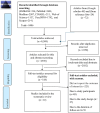Psychosocial treatment options for adolescents and young adults with alcohol use disorder: systematic review and meta-analysis
- PMID: 39114525
- PMCID: PMC11303970
- DOI: 10.3389/fpubh.2024.1371497
Psychosocial treatment options for adolescents and young adults with alcohol use disorder: systematic review and meta-analysis
Abstract
Introduction: Psychosocial intervention is imperative for treating alcohol use disorder (AUD), but there is no comprehensive evidence regarding its effectiveness. Therefore, this study aimed to determine the effectiveness of psychosocial interventions in treating AUD amongadolescents and young adults.
Methods: In this systematic review and meta-analysis, articles were searched from EMBASE, PubMed, Medline, CINAHL, Web of Science, PsycINFO, and Scopus. Also, articles were retrieved from gray literature. The quality of articles has been assessed using the Cochrane risk of bias assessment.
Results: A total of 12 randomized controlled trials were included. Integrated family and CBT, CBT, guided self-change, and ecologically based family therapy had a mild effect in reducing alcohol use frequency. On the other hand, integrated motivational enhancement therapy and CBT (-0.71 [95% CI: -0.97, -0.45]) and common elements treatment approaches (4.5 [95% CI: 6.9, 2.2]) had the highest effect size for reducing alcohol use frequency and amount, respectively. In conclusion, most of the interventions had no significant effect on different drinking outcomes. Nonetheless, the effectiveness of combined interventions surpassed that of the single interventions. The effect of psychosocial interventions on abstinence was inconclusive. Therefore, future studies will explore alternative, newly emerged third-wave therapeutic approaches.
Systematic review registration: PROSPERO, CRD42023435011, https://www.crd.york.ac.uk/prospero/display_record.php?RecordID=435011.
Keywords: adolescents; alcohol use disorder; psychosocial interventions; systematic review; young adults.
Copyright © 2024 Belay, Mak, Wong, Lam, Liu, Yang, Mao, Wu and Ho.
Conflict of interest statement
The authors declare that the research was conducted in the absence of any commercial or financial relationships that could be construed as a potential conflict of interest.
Figures
References
-
- CDC (2022). Alcohol and public health; underage drinking. Available at: https://www.cdc.gov/alcohol/fact-sheets/underage-drinking.htm
-
- WHO (2023). Adolescent health. Available at: https://www.who.int/health-topics/adolescent-health#tab=tab_1
-
- NIH (2021). Alcohol use disorder: A comparison between DSM–IV and DSM–5 on on alcohol abuse or alcoholism. https://www.niaaa.nih.gov/publications/brochures-and-fact-sheets/alcohol...
Publication types
MeSH terms
LinkOut - more resources
Full Text Sources
Medical





